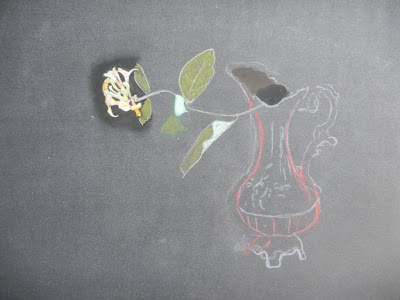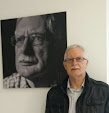It is July 3 in Ireland, and since my last post it has not stopped raining. On the bright side there's no gardening to interfere with painting.
This pitcher is giving great inspiration. The honeysuckle was growing in the garden, and the elephant hawkmoth is a species I have raised from larval stage. I decided to combine the lot in a composition that is not outlandish, zoologically speaking - the hawkmoth visits honeysuckle in the evening.
First sketch. The layout and placement are sketched fairly loosely with pastel pencils. I have already started to develop the blossom.
In order to get an idea of the contrast and too allow for a dark background for the stamens, I have rubbed black pastel pencil in firmly around the flowerhead.

This is the completed sketch and block in. It needs to have the dark background added soon to finalise the colour contrast.
 This image is showing me that the colour of the back of the leaves is too light.
This image is showing me that the colour of the back of the leaves is too light.
This is a close-up of the pitcher. It has more colour than my previous treatments of the subject.

 This is where I've left it for now. It will need some refining, but it can sit in the dark for a while, until I view it afresh. The painting is on Clairefontaine's Pastelmat, 11 x 14 ins.
This is where I've left it for now. It will need some refining, but it can sit in the dark for a while, until I view it afresh. The painting is on Clairefontaine's Pastelmat, 11 x 14 ins.













































